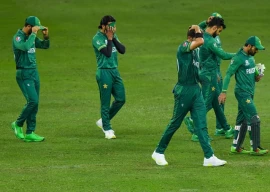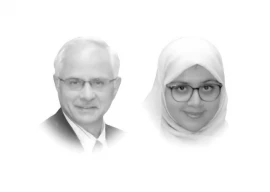
There are three state actors involved in the issue — Pakistan, the United Arab Emirates and the United States. One can be sure that none is likely to tell the truth. But, as Bacon said, if something “be thought secret, it inviteth discovery; as the more close air sucketh in the more open”. So, let’s begin with what is known.
In his book In the Line of Fire, this is what former general-president Pervez Musharraf wrote in detailing the US demands after 9/11:
“How could we allow the US ‘blanket overflight and landing rights’ without jeopardising our strategic assets? I offered only a narrow flight corridor that was far from any sensitive areas. Neither could we give the US ‘use of Pakistan’s naval ports, air bases, and strategic locations on borders.’ We refused to give any naval ports or fighter aircraft bases. We allowed the US only two bases — Shamsi in Balochistan and Jacobabad in Sindh — and only for logistics and aircraft recovery. No attack could be launched from there. We gave no ‘blanket permission’ for anything.”
We gave permission? Fast forward to now. The prime minister and the defence minister say that we can’t throw out the US equipment and personnel because the Shamsi base does not belong to Pakistan, having been leased out to the UAE in 1992. According to this version, the operational control of the base was handed over to the US by the UAE, not Pakistan.
This is corroborated apparently by what the Pakistan Air Force representative told parliament in the in-camera session following the May 2 Abbottabad raid.
Then we have a 2005 US diplomatic cable which says the UAE government is displeased “at leak of reports about its military cooperation with the United States inside Pakistan” contained in American Soldier, a book by General Tommy Franks, former commander of US central command. Franks had written about the use by the US of Sheikh Zayed’s private airstrip in Balochistan.
The cable read: “UAE government desires to keep details of the UAE cooperation with the US military in Afghanistan and Pakistan confidential, because the government is concerned that public acknowledgement of this assistance could pose risks to the UAE security within the UAE or to UAE officials in Pakistan.”
Is Musharraf lying about having permitted the US the use of Shamsi and Jacobabad? Perhaps not. But let’s first raise a few more questions.
What is the nature of this lease? Is it a private international law agreement (PILA) or in the nature of a treaty? If it’s the former, which means an agreement between a government and a private party, then the government of the state to which the private party belongs can intervene and cancel the agreement. This happened in the F-16 case in which the government of Pakistan had entered into an agreement with the manufacturer of the aircraft. The US government, when it slapped sanctions on Pakistan, intervened in that agreement. Reko Diq in Balochistan is another case in point.
Even if the PILA is between the UAE government and the Balochistan government, the federal government can override it because Balochistan is a federating unit. We also don’t know whether the private party, if any, is on the Pakistani side or whether, in this case, the UAE’s royal family has entered as a private party into a lease agreement with Pakistan.
If, on the other hand, the lease is governed by a treaty, then it becomes a sovereign agreement and the nature of the debate changes. It would still be necessary to see whether such an agreement allows the UAE to sub-lease the use of the base to a third party. And if that be the case, whether a sub-lease would also require that the government of Pakistan agree to such arrangement. Nor do we know what constraints the third party will have to work with and who would monitor such compliance.
In the absence of any documents, one can only conjecture. But chances are that any sub-lease by the UAE would need the government of Pakistan’s permission. This is the only way we can square the contents of the US government diplomatic cable with the account given by Musharraf in his book.
This still leaves out the issue of whether the use of the base was confined to recovery of aircraft and logistics. We are now told the US could only mount surveillance flights but there is much evidence that the US also mounted attack flights from the base of MQ1-A Predators. Since when is the question.
The Predator drones had become weapons-capable before 9/11 happened. The first successful test was conducted in February 2001 at Nellis Air Force base. That the US had already begun planning taking out Osama bin Laden is proved by reports that in June 2001 a Hellfire AGM-114C missile was launched on a replica of bin Laden’s Afghanistan residence built at a Nevada test site. Flying from a base in Uzbekistan, it was in February 2002 that an MQ1-A was used to attack a convoy of SUVs inside Afghanistan.
It seems that this is where both the UAEG and the government of Pakistan have been dissembling. The base was handed over to the Americans and everyone was looking the other way over its use. One can’t be sure of when exactly the USG deployed the Predators at Shamsi but it is safe to assume that the base was primarily used for Predator flights. The story was first broken by Zahid Hussain in February 2009 for The Times of London.
It may be noted that when these birds were flying from Uzbekistan, even after the Predators had become weapons-capable, the USG could not operate armed flights until Uzbekistan permitted such flights. So, we can be sure that in this ménage à trois, all three parties were of age and consenting.
Except that now the situation has changed and the government of Pakistan wants an end to this arrangement. That is where the nature of the agreement with UAEG and its politics comes in. There is, of course, the overhang also of Pakistan-US relations, already at their lowest. It is, therefore, not just a matter of evicting the Americans but also dealing with the consequences of doing so vis-a-vis both the USG and the UAEG. Since no course of action is without its costs, it all depends on what it is that the actors consider their optimal and suboptimal choices and whether they are playing a nested game.
Finally, even if we consider Shamsi to be sovereign UAE territory which it could sub-lease to a third party, does a bird flying from Shamsi enter UAE airspace or Pakistan’s?
Published in The Express Tribune, July 5th, 2011.

















COMMENTS
Comments are moderated and generally will be posted if they are on-topic and not abusive.
For more information, please see our Comments FAQ